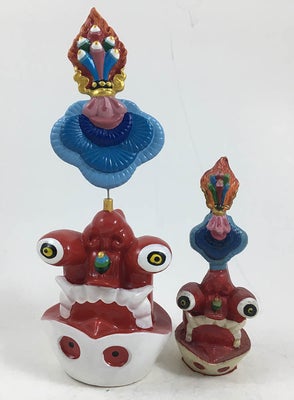Lama Zopa Rinpoche Explains Tormas
What exactly are tormas? The word is Tibetan (the Sanskrit is balingta) and refers to an offering cake used in rituals. There are various different types of tormas for different purposes.
Tormas can be ornamented in many ways, such as with discs molded from butter that represent the sun and moon. More elaborate tormas feature multiple colors. In Tibet, tormas were
usually made of tsampa (roasted barley flour), but these days other edibles such as biscuits can also be used. The practice of offering tormas can be a way to accumulate merit and eliminate obstacles.
Lama Zopa Rinpoche explained the origins and meaning of the word torma during teachings at Shakyamuni Center in Taiwan in February 2007.
“Tor in Tibetan is that which, when the hurricane or tornado comes, the whole city, whole town, after one hour, is totally destroyed, everywhere pieces, all the houses gone, so all the pieces are tor. Or when in a field you plant crops you throw seeds, this is called tor. Or when you give grain, when you give food to
birds, you tor, but not so much that, tor is more like the hurricane destroying a city or town, after half an hour, one hour, totally, everything is scattered. Tor is like that, something scattered or destroyed. Tor is more in the sense of destroy. So torma, that which destroys.
“So one meaning of torma is destroying miserliness, your miserliness, so therefore torma are made very rich, the best and richest quality you can make. It means you spend money destroying your miserliness, making a good offering to the deity. So that’s one meaning of tor, that which destroys your miserliness, your attachment.
“Then the other meaning is related also to the maha-anuttara tantric path, where the experience of transcendental wisdom, the great bliss, the voidness, is the real torma. That is the real torma … So then that tor destroys like a bomb; it destroys the root of samsara: the ignorance holding the I, the aggregates, to be truly existent. So the torma is that which destroys that …
“Just one more word, then finish. Why do Tibetans make tormas so beautiful, with decorations and shapes, as beautiful as they can make them? It creates the cause to have beautiful bodies in future lives if you make the tormas very beautiful …”
Source
[[1]]
